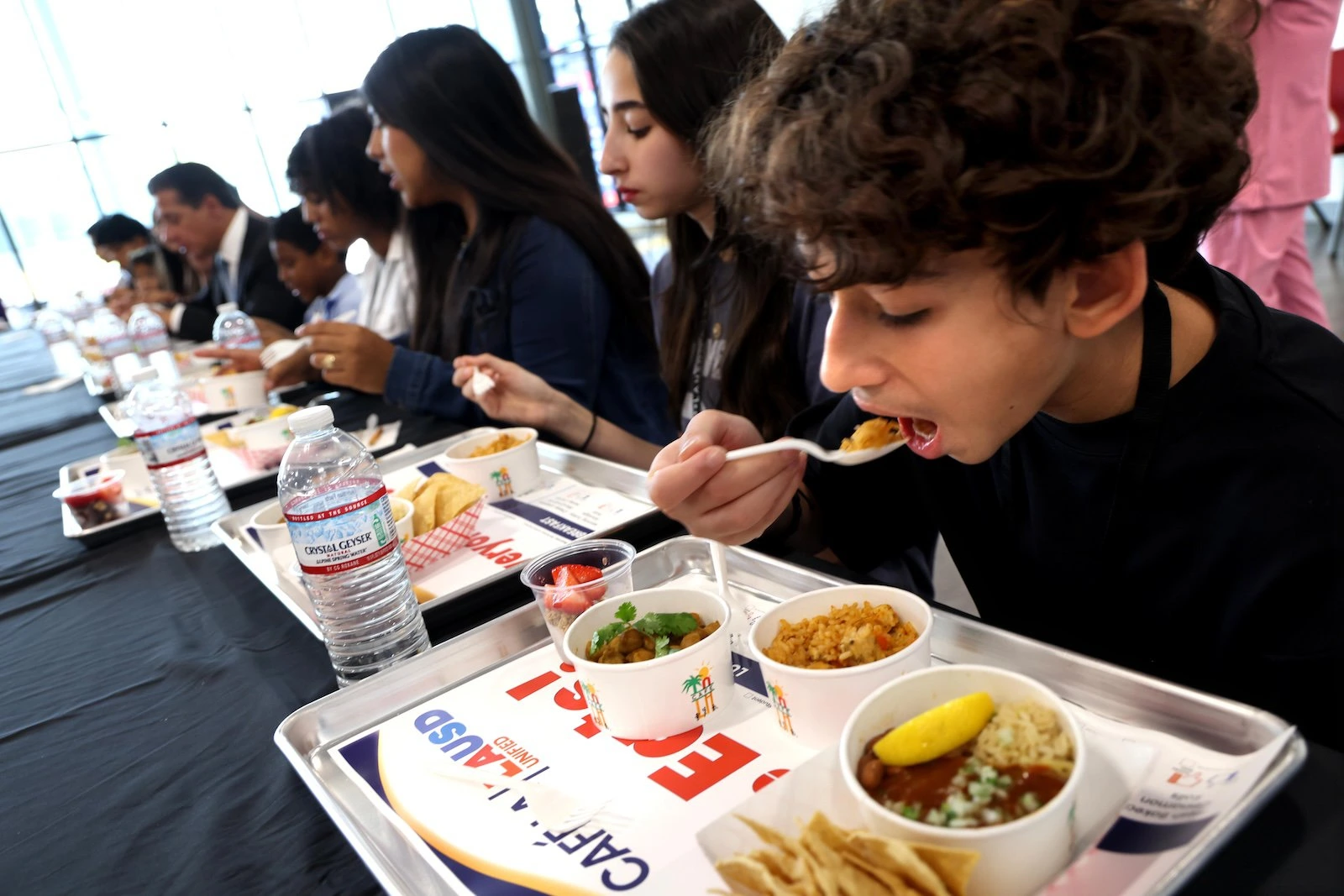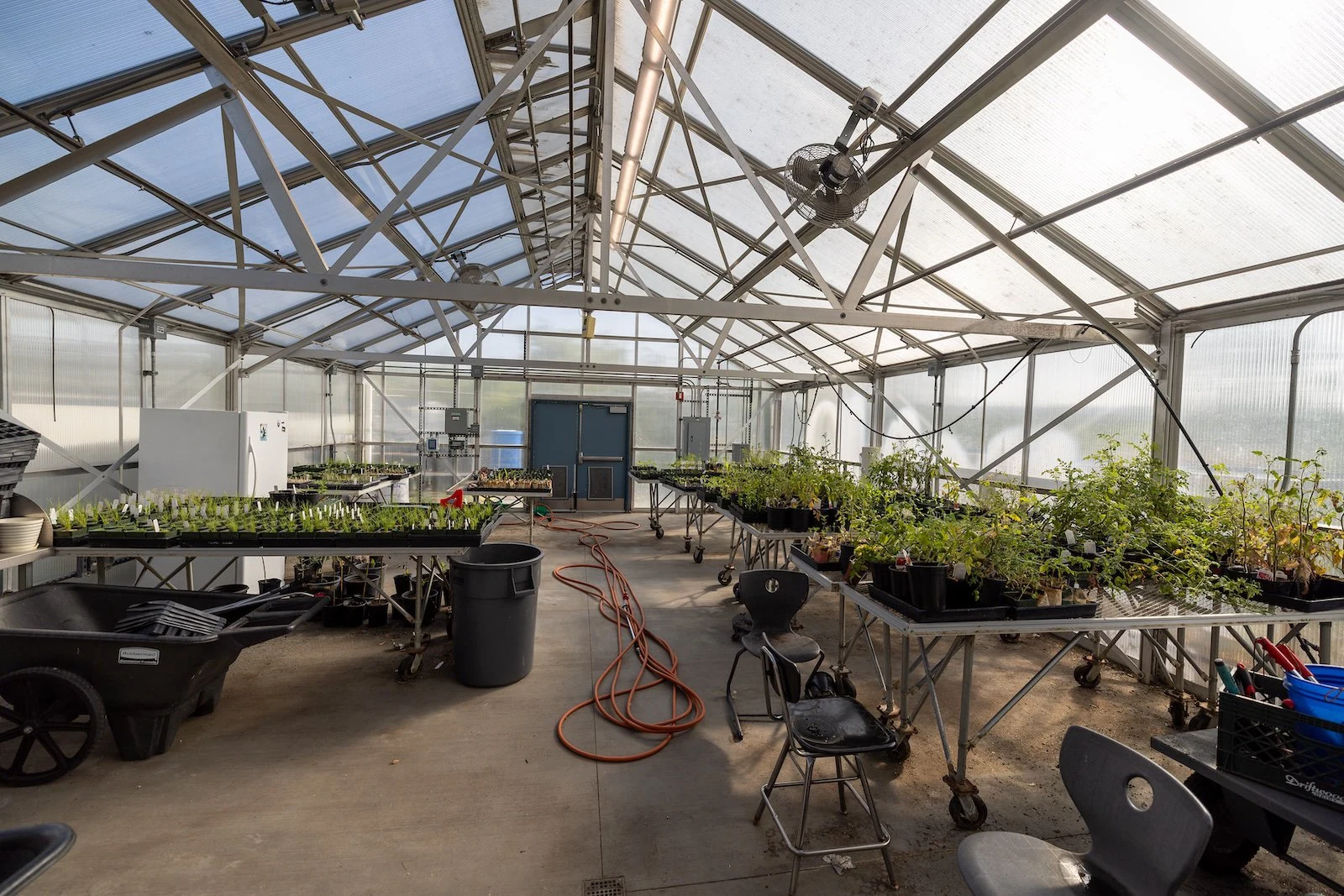This story was originally published by Grist. Sign up for Grist’s weekly newsletter here.
Three years ago, Erin Primer had an idea for a new summer program for her school district: She wanted students to learn about where their food comes from. Primer, who has worked in student nutrition within California’s public school system for 10 years, applied for grant funding from the state to kick off the curriculum, and got it. Students planted cilantro in a garden tower, met a local organic farmer who grows red lentils and learned about corn. “Many kids didn’t know that corn grew in a really tall plant,” said Primer. “They didn’t know that it had a husk.”
The curriculum, focused on bringing the farm into the school, had an effect beyond the classroom: Primer found that, after learning about and planting ingredients that they then used to make simple meals like veggie burgers, students were excited to try new foods and flavors in the lunchroom. One crowd pleaser happened to be totally vegan: a red lentil dal served with coconut rice.
“We have had students tell us that this is the best dish they’ve ever had in school food. To me, I was floored to hear this,” said Primer, who leads student nutrition for the San Luis Coastal district on California’s Central Coast, meaning she develops and ultimately decides on what goes on all school food menus. “It really builds respect into our food system. So not only are they more inclined to eat it, they’re also less inclined to waste it. They’re more inclined to eat all of it.”
Primer’s summer program, which the district is now considering making a permanent part of the school calendar, was not intended to inspire students to embrace plant-based cooking. But that was one of the things that happened — and it’s happening in different forms across California.
A recent report shows that the number of schools in California serving vegan meals has skyrocketed over the past five years. Although experts say this growth is partly a reflection of demand from students and parents, they also credit several California state programs that are helping school districts access more local produce and prepare fresh, plant-based meals on-site.
Crushed by negative news?
Sign up for the Reasons to be Cheerful newsletter.
Growing meat for human consumption takes a tremendous toll on both the climate and the environment; the U.N. Food and Agriculture Organization estimates that livestock production contributes 12 percent of global greenhouse gas emissions. Specifically, cattle and other ruminants are a huge source of methane. Animal agriculture is also extremely resource-intensive, using up tremendous amounts of water and land. Reducing the global demand for meat and dairy, especially in high-income countries, is an effective way to lower greenhouse gas emissions and mitigate the rate of global warming.
The climate benefits of eating less meat are one reason that school districts across the country have introduced more vegetarian — and to a lesser degree, vegan — lunch options. In 2009, Baltimore City Public Schools removed meat from its school lunch menus on Mondays, part of the Meatless Mondays campaign. A decade later, New York City Public Schools, the nation’s largest school district, did the same. In recent years, vegan initiatives have built upon the success of Meatless Mondays, like Mayor Eric Adams’ “Plant-Powered Fridays” program in New York City.

But California, the state that first put vegetarianism on the map in the early 20th century, has been leading the country on plant-based school lunch. “California is always ahead of the curve, and we’ve been eating plant-based or plant-forward for many years — this is not a new concept in our state,” said Primer. A recent report from the environmental nonprofit Friends of the Earth found that among California’s 25 largest school districts, more than half — 56 percent — of middle and high school menus now have daily vegan options, a significant jump compared to 36 percent in 2019. Meanwhile, the percentage of elementary districts offering weekly vegan options increased from 16 percent to 60 percent over the last five years.
Student nutrition directors like Primer say the foundation that allows schools to experiment with new recipes is California’s universal free lunch program. She notes that, when school lunch is free, students are more likely to actually try and enjoy it: “Free food plus good food equals a participation meal increase every time.”
Nora Stewart, the author of the Friends of the Earth report, says the recent increase in vegan school lunch options has also been in response to a growing demand for less meat and dairy in cafeterias from climate-conscious students. “We’re seeing a lot of interest from students and parents to have more plant-based [meals] as a way to really help curb greenhouse gas emissions,” she said. A majority of Gen Zers — 79 percent — say they would eat meatless at least once or twice a week, according to research conducted by Aramark, a company provides food services to school districts and universities, among other clients. And the food-service company that recently introduced an all-vegetarian menu in the San Francisco Unified School District credits students with having “led the way” in asking for less meat in their cafeterias. The menu includes four vegan options: an edamame teriyaki bowl, a bean burrito bowl, a taco bowl with a pea-based meat alternative and marinara pasta.

Stewart theorizes that school nutrition directors are also increasingly aware of other benefits to serving vegan meals. “A lot of school districts are recognizing that they can integrate more culturally diverse options with more plant-based meals,” said Stewart. In the last five years, the nonprofit found, California school districts have added 41 new vegan dishes to their menus, including chana masala bowls, vegan tamales, and falafel wraps. Dairy-free meals also benefit lactose-intolerant students, who are more likely to be students of color.
Still, vegan meals are hardly the default in California cafeterias, and in many places, they’re unheard of. Out of the 25 largest school districts in the state, only three elementary districts offer daily vegan options, the same number as did in 2019. According to Friends of the Earth, a fourth of the California school districts they reviewed offer no plant-based meal options; in another fourth, the only vegan option for students is a peanut butter and jelly sandwich. “I was surprised to see that,” said Stewart.
Making school lunches without animal products isn’t just a question of ingredients. It’s also a question of knowledge and resources — and the California legislature has created a number of programs in recent years that aim to get those tools to schools that need them.

In 2022, the state put $600 million toward its Kitchen Infrastructure and Training Funds program, which offers funding to schools to upgrade their kitchen equipment and train staff. This kind of leveling up allows kitchen staff to better incorporate “scratch cooking” — essentially, preparing meals on-site from fresh ingredients — into their operations. (The standard in school lunch sometimes is jokingly referred to as “cooking with a box cutter,” as in heating up and serving premade meals that come delivered in a box.) Another state program, the $100 million School Food Best Practices Funds, gives schools money to purchase more locally grown food. And the Farm to School incubator grant program has awarded about $86 million since 2021 to allow schools to develop programming focused on climate-smart or organic agriculture.
Although only the School Food Best Practices program explicitly incentivizes schools to choose plant-based foods, Stewart credits all of them with helping schools increase their vegan options. Primer said the Farm to School program — which provided the funding to develop her school district’s farming curriculum in its first two years — has driven new recipe development and testing.
All three state programs are set to run out of money by the end of the 2024-2025 school year. Nick Anicich is the program manager for Farm to School, which is run out of the state Office of Farm to Fork. (“That’s a real thing that exists in California,” he likes to say.) He says when state benefits expire, it’s up to schools to see how to further advance the things they’ve learned. “We’ll see how schools continue to innovate and implement these initiatives with their other resources,” said Anicich. Stewart says California has set “a powerful example” by bettering the quality and sustainability of its school lunch, “showing what’s possible nationwide.”
One takeaway Primer has had from the program is to reframe food that’s better for the planet as an expansive experience, one with more flavor and more depth, rather than a restrictive one — one without meat. Both ideas can be true, but one seems to get more students excited.
“That has been a really important focus for us. We want [to serve] food that is just so good, everybody wants to eat it,” Primer said. “Whether or not it has meat in it is almost secondary.”
This article originally appeared in Grist at https://grist.org/food-and-agriculture/california-vegan-school-lunch-plant-based-environmental-climate-grants/.
Grist is a nonprofit, independent media organization dedicated to telling stories of climate solutions and a just future. Learn more at Grist.org
The post More California Schools Than Ever Are Embracing Vegan Meals appeared first on Reasons to be Cheerful.




